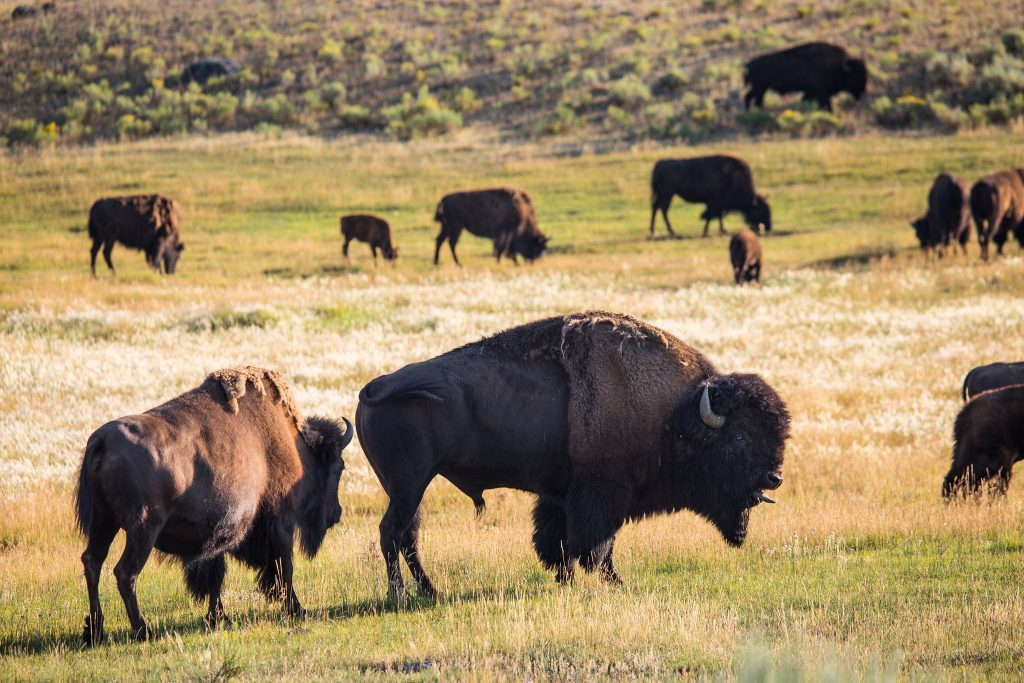Getting a Glimpse of the Iconic Yellowstone Bison
Each year, millions of people from around the world journey to America’s first national park hoping to see bison in Yellowstone.
Yellowstone National Park doesn’t have an official mascot, but if it did, the bison (Bison bison) would have a pretty strong claim to the title.
As the United States grew, people hunted bison to the brink of extinction. In 1902, the entire Yellowstone bison population hovered at roughly two dozen animals in size.
You can find bison elsewhere in the US, but Yellowstone is the only place in the continguous 48 states that has been home to a free-ranging bison population since prehistoric times.
These animals are quite a distinct sight, but visitors should view them with caution. Though bison may appear docile, they should not be confused with livestock. These enormous mammals are extremely powerful and deceptively quick, so visitors should always stay at least 25 yards from bison and maintain a safe distance at all times, even if the animal moves closer to you.
So now that you know how to view them safely, here’s a guide to the four best places to see bison in Yellowstone National Park.
1. Hayden Valley
The Hayden Valley is a great place to see bison because they’re frequently present here and a heavily-used portion of the lower loop road passes right through it, meaning you often don’t even need to get out of your vehicle to see bison.
Located near the center of the park, Hayden Valley is six miles north of Fishing Bridge and was once filled with water, which made it an arm of Yellowstone Lake at the time.
There are plenty of vehicle pullouts and a few places to park along the road in Hayden Valley, and visitors should use them. The road in this area has only two lanes, so it’s easy for distracted drivers to cause accidents or significant delays.
Other wildlife you can spot in Hayden Valley include grizzly bears, elk, and wolves, though you’re much more likely to spot dozens of bison belonging to the park’s central breeding herd.
2. Lamar Valley
Lamar Valley (and the nearby plateaus) is where Yellowstone’s northern herd tends to gather. However, depending on your travel plans, you may have to take a detour to get to this area.
But, because this portion of the park is more remote, it’s a fantastic place to see bison and other Yellowstone wildlife.
Lamar Valley is located between Tower-Roosevelt and the park’s Northeast Entrance near Silver Gate, Montana. At roughly the halfway point, you’ll find the Lamar Buffalo Ranch. It was built in the early 1900s to save the herd from extinction and help bison make a comeback.
The ranch isn’t open to the general public, but four of the original buildings remain and are on the National Register of Historic Places.
3. Tower-Roosevelt
Located at the northeast corner of the upper loop road — your last stop before the Lamar Valley and the Northeast Entrance — Tower-Roosevelt is an excellent place to see Bison in Yellowstone and take in a number of other pristine sights.
Tower Fall itself is something to behold. It’s 132-foot drop has captured the attention of visitors since the first Europeans entereed the region.
In fact, Thomas Moran’s painting of Tower Fall helped further the movement to establish Yellowstone as a national park in 1872.
As with other areas of the park, it’s not uncommon for bison to cross the road at will (they’re absolutely awful at using crosswalks), so drive with caution and don’t be surprised if a “buffalo jam” puts you behind schedule.
4. Old Faithful and Other Geyser Basins
To be clear, if you’re visiting one of the park’s many geothermal features, you should expect to see plenty of steam and be prepared to take in the power of the earth.
Although they aren’t as common at Old Faithful and the park’s geyser basins as they are in other areas, bison can sometimes be seen near these geothermal features. So, when you’re walking the boardwalk at Old Faithful or Norris, be sure to keep your eyes open.
Of course, the greater the crowds, the slimmer your chances of seeing bison in these areas.
Please keep in mind that visitors absolutely must remain on the boardwalks in geothermal areas.
The ground is often thin and quite brittle in these areas, so you could become seriously injured if you leave the boardwalk. You could also cause irreparable damage to the colorful cyanobacteria and other thermophiles that make these geothermal features one of Yellowstone’s treasures.
Each year, a number of Yellowstone’s guests set bad examples for the rest of us. Check out our helpful guide to responsibly enjoying Yellowstone National Park in order to ensure you and anyone traveling with you know the dos and don’ts.
Remember, wildlife are just that: wild. You never know when you might come across bison, bears, or other animals while visiting Yellowstone National Park, so keep your wits about you and your camera handy.
If you’ve never visited Yellowstone before, here’s what you need to know about entrance permits and the park’s fee structure.










